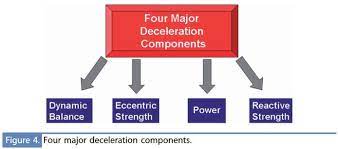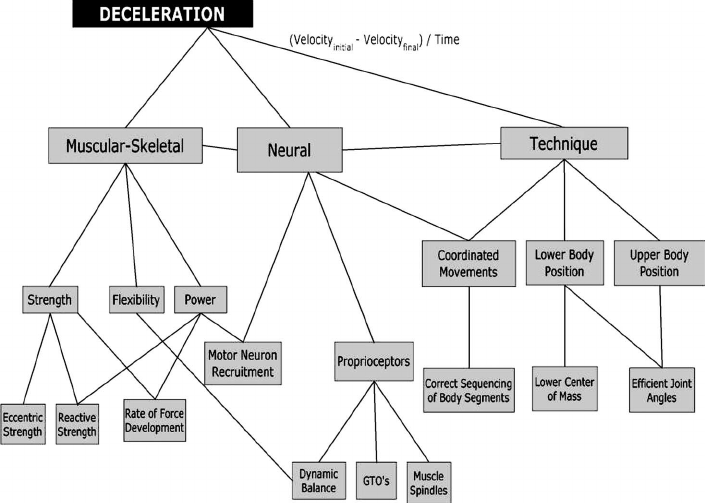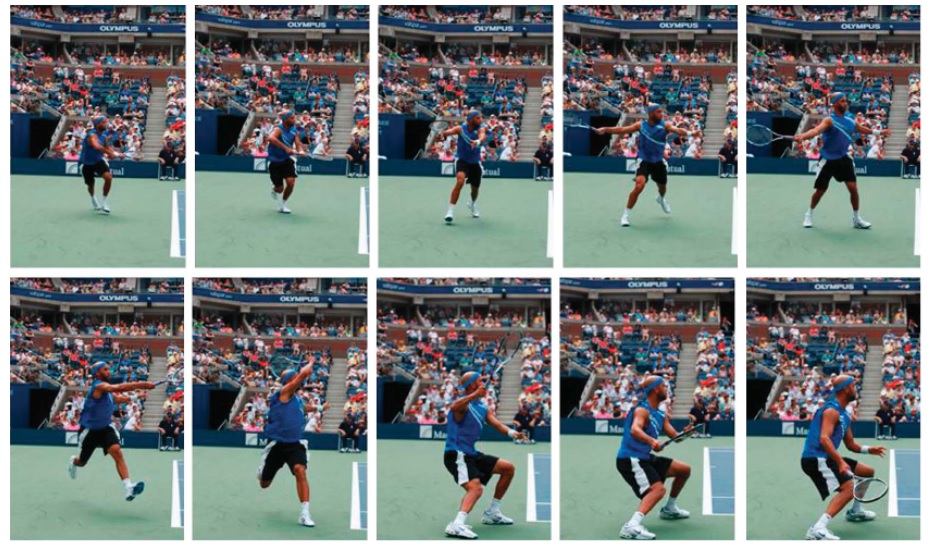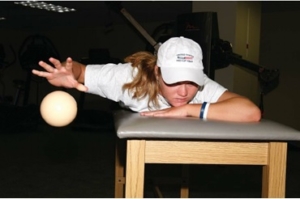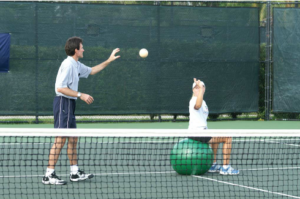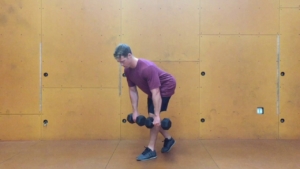Deceleration- The Forgotten Factor
With the end of a third lock down in the UK behind us, we haven’t slowed down in our vision to be the Best Tennis S&C Team in the World. We are committed to a weekly CPD session and last week Konrad gave us an exceptional presentation, the content of which we wanted to share with you! We welcome back APA coach Konrad McKenzie with a weekly guest post.
Deceleration – The Forgotten Factor
Last week I spoke about what I had taken away from Nick Winkleman’s “Language of coaching”. Today I wanted to write about an insightful paper that I happened to stumble upon. “Efficient deceleration: The forgotten factor in Tennis specific training”. Whilst I am not entirely convinced that it is a “forgotten factor” I acknowledge the provocative title. This paper is excellent and I am excited to share it with you. Today’s topics (based on the paper) are:
- Deceleration components
- Lower and upper body deceleration
- Deceleration components explained further
- Five exercises for you to try
As always I am using this as an opportunity to write about what I have learnt in the hope that it directs you towards the paper, rather than simply regurgitating it. So, I implore you to read it through the link here
Four major deceleration components
I thought I would mix the order of the paper to enlighten you on 1) what deceleration is 2) Why it is important 3) and what are the rate limiting factors to deceleration performance. Deceleration simply put is the reduction in speed or rate. Sufficient deceleration is pertinent to most field and court sports but in Tennis in particular, deceleration is important in order to set up prior and recover after the shot.
In the upper extremities deceleration occurs in the arms and shoulders after ball contact (e.g serves and groundstrokes). As mentioned deceleration is multifaceted, meaning that it has components for successful performance.
“Training acceleration is important to improve athletes speed, however it may not transfer if athlete cannot decelerate faster velocities in appropriate time frames & under control”.
Interestingly, the percentage breakdown of total distance covered in respective speed bands during the Australian open years (2012-2014) showed that the majority of movements occurred under 3m/s highlighting the multi-directional explosive actions and sudden braking demands. In the junior game players may experience deceleration speeds of up to -5.2.m/s. This demand will vary for individuals with larger body mass as a result of momentum (Mass x Velocity).
(Photo credit: Kovacs et al., 2008)
I will elaborate on these topics later however, the paper catergorises the major components components of deceleration as:
1. Dynamic balance
2. Eccentric strength
3. Power and
4. Reactive strength
As scientific thinkers we like to catergorise things into neat little boxes however as we can see by the next picture in the deterministic model of deceleration there are a few factors that influence it. We must not forget the skill component.
(Photo credit: Kovacs et al., 2008)
Lower and upper body decelerations
I will now delve a bit further into the deceleration of the lower body and upper body and what is occurring at these regions.
“Deceleration is trainable bio motor skill and as such, needs to be included in a well-rounded tennis specific training program”
As mentioned above training acceleration should not be neglected however, the paper suggests that athletes need to able to decelerate the faster velocities in the appropriate time frames in order to be effective. Check out the figure below, the athlete pictured needs the strength (along with balance and coordination) to accelerate into the forehand and decelerate immediately after ball contact.
(Photo credit: Kovacs et al., 2008)
Also check out this world-class rally where this is mentioned further. Something else to note is that high braking forces during the “penultimate step” can increase the risk for injury (Dos santos et al.,2018) if change of direction technique and strength levels are poor.
The body uses eccentric contractions after ball contact in virtually all serves and ground strokes. These contractions are of vital importance, virtually all strokes require deceleration of the upper extremity within the kinetic chain. High powered movements such as the serve require high levels of strength around the scapula and shoulder region, due to the large forces generated by the internal rotators such as the Latissimus Dorsi and the pectoralis Major. These muscles accelerate the arm forward for an explosive ball contact, all this is happening with an arm elevation of the arm (approx. 90-100°).
After ball contact an increasing demand is placed on the Scapula-thoracic stabilisers (Infraspinatus, Teres major, Teres minor, serratus anterior, trapezius and Rhomboids) as they perform eccentric work to decelerate the arm as it continues to internally rotate. Interestingly Fleiseg et al reported forces of up to 1 x bodyweight through the Gleno-humeral joint. Kovacs argues that players lack the vital deceleration capacities in the upper body which amplifies their risk of injury.
Deceleration components of deceleration explained further
This article goes into quite a bit of depth regarding the four components, I will touch on these briefly to avoid making this blog too long.
Power and reactive strength
Power is said to directly translate into greater racket head speed and ball velocity. Increased power qualities is said to improve the athletes ability to brake via the restrain mechanism. The restrain mechanism also serves to protect the structures of the hips knees and ankles. Reactive strength is enhanced as a result of training due to the adaptations in the sensorimotor system. From a neuromuscular perspective the stretch reflex is initiated during the eccentric (landing) resulting in greater motor unit contraction during the subsequent concentric action. A longer term adaptation to Plyometric training is the desensitization of the Golgi Tendon Organs (GTO) which allows the elastic component of the muscle to go through a greater stretch. In terms of performance this results in an increase in power and speed.
Eccentric Strength
Training an eccentric contraction requires selecting exercises which lengthen muscles under tension. An example eccentric action in tennis would be in the loading phase in a shot or the penultimate step. Tennis movement places an asymmetrical load on the body and it is argued that these uneven loading patterns are trained eccentrically. A lack of eccentric strength in the lower and upper extremities heightens the risk of injury. The paper has training recommendations for this if you wish to delve deeper but I was particularly interested in this:
“Length–tension curves for single fibres (sarcomeres), whole muscle, and single joints all have different shapes. As the result of these different shapes, it is vital for the athlete to be trained at a variety of angles and torques to stimulate adaptations in as many muscle fibres as possible to capture the greatest effect on altering the length–tension relationships specifically during eccentric dominant movements.”
Dynamic balance
Firstly dynamic balance is the ability for an athlete to maintain a stable centre of gravity while the athlete is moving. A well balanced athlete allows to successfully use the segmental summation of muscular forces and movements through the kinetic chain (Kibler, 1994). Efficient energy transfer from the ground up through the kinetic chain will result in more efficient and powerful tennis stroke. I’ll assume that the paper accounts for Rhythm, timing and proper contact with the ball. In a recent webinar that I took part in, the word “confident” was used as opposed to “Certain” which, in my opinion, encapsulates the complexity in human performance and Tennis. By enhancing dynamic balance we allow for proper intermuscular coordination reducing the chances of compensatory movement patterns. Whilst experts do not agree on athlete specific balance, researchers suggest that changes in both sensory and motor systems enhance balance (Bressel, 2007).
5 exercises for you to try
The paper has some exercises which are used to enhance the eccentric and rate of force development capabilities around the shoulder girdle and in the lower body (Hip extensors, Glutes and hamstring muscles). I will add in some exercises outside of the paper which I also found interesting.
- 90/90 shoulder prone plyometric drop
See Video example HERE
- Reverse catch deceleration
See Video example HERE
- Medball side lying drop catch
- Split Stance RDL
- Lateral hurdle run with hold
Tennis is a wonderful game which challenges fine motor skills, inter and intra muscular coordination. Preparation for the Tennis athlete is by no means a simple task if we appreciate the competing demands of the sport. I hope you have enjoyed, please read the paper for a more in depth discussion.
Thanks for reading guys,
Konrad McKenzie
Strength and Conditioning coach.
Liked This Blog?
You might like other blogs on this topic from APA:
APA review of the Middlesex Students S&C conference 2014
The Dubious Rise of the Corrective Exercise ”Pseudo-Physio” Posing as a Trainer- My thoughts
as well as two recommended articles:
This article on weak Glutes during Squatting
And this one on Exercise Modifications
Do you feel that this would be a perfect time to work on the weak links that you have been avoiding? The things that you know you should be doing that you keep putting off? Would you like us to help you with movement screening and an injury prevention program? Then click on the link below and let us help you!
? TRAIN WITH APA ?
Aspiring Pro Training Support Packages
Follow me on instagram @konrad_mcken
Follow Daz on instagram @apacoachdaz
- If you’re not subscribed yet, click here to get free email updates, so we can stay in touch.
- Share this post using the buttons on the top and bottom of the post. As one of this blog’s first readers, I’m not just hoping you’ll tell your friends about it. I’m counting on it.
- Leave a comment, telling me where you’re struggling and how I can help
Since you’re here…
…we have a small favor to ask. APA aim to bring you compelling content from the world of sports science and coaching. We are devoted to making athletes fitter, faster and stronger so they can excel in sport. Please take a moment to share the articles on social media, engage the authors with questions and comments below, and link to articles when appropriate if you have a blog or participate on forums of related topics. — APA TEAM


